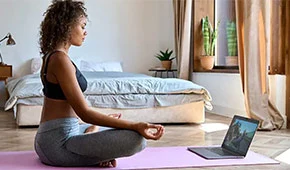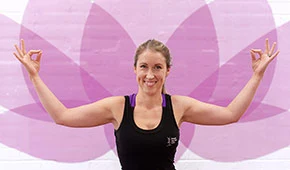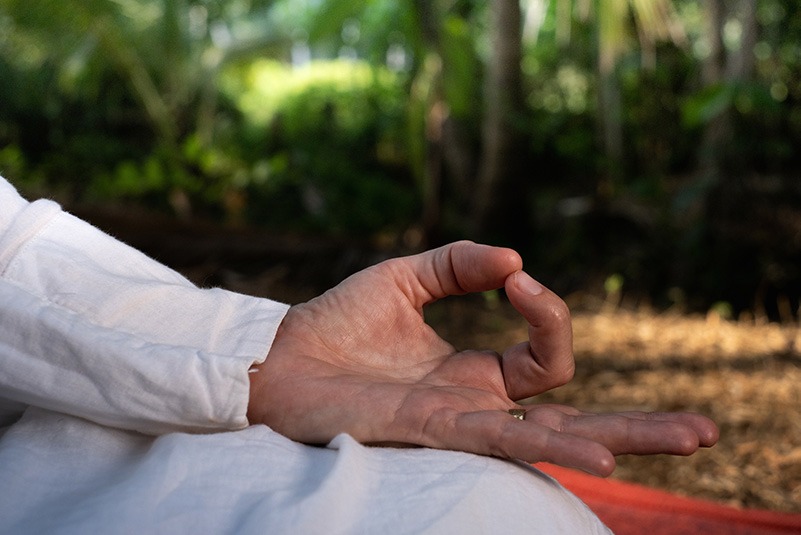
Looking at Stress through the lens of Emotional Anatomy, Yogic Psychology and Neuroplasticity
“By understanding our emotional anatomy, we see how stress impacts our posture and immune system.” – Adam Divine
Resilience is our ability to bounce back from what life throws at us – in essence, our inner strength. In order to build resilience, we need to take responsibility for ourselves, the stories that we create and see how we can create more conscious and sustainable ways of inhabiting our bodies through the myriad of day-to day-experiences.
Stress is often demonized, but like everything else, it teaches us about ourselves
Stress responses are part of our natural human functioning and so learning how to efficiently cope with stress is our best defence. Stress is often demonized, but like everything else, it teaches us about ourselves, our values and how we see ourselves in relation to the world-at-large.
Stress becomes a habit like anything else – this impacts how we think (habitual thoughts and beliefs), how we act (toxic behaviours and addictions) and even how we stand (postural tension) – and naturally they all feed into each other and can be the root cause of physical and mental illness. And, stress is never content to be alone and manifests as anxiety, depression and disassociation.
Yoga and meditation help us recognise how we hold onto stress and anxiety in the body. Research has shown that various forms of meditation and relaxation practices like restorative yoga and MBSR (mindfulness-based stress reduction) have powerful effects on how our bodies deal with stress.
Positive effects of restorative yoga and MBSR:
- Lowering cortisol (stress hormone),
- Reducing inflammation (often tangible signs of stress in the body is a prolonged inflammation response)
- Improving digestion (our gut-brain is where most of our serotonin or mood regulator is produced)
- Increasing our capacity to concentrate and help with sleep disturbances, and this all, in turn, improves our immunity and general felt-sense of well-being.
“Through yoga, interoception (anchoring ourselves in bodily sensations) and awareness practices, we start to understand how our body not only sculpts itself around our most common activities, but also around our most common thoughts and emotions,” says Adam Divine. “By understanding our emotional anatomy, we see how stress impacts our posture and immune system.”
This is Your Body on Stress
Chemical messengers are at the heart of our stress response. While experiencing or witnessing a dangerous or shocking event, fear triggers a rush of hormones like cortisol and adrenalin which mobilize the body and our nervous system (fight or flight). Once the threat passes, the nervous system usually resets and balance is restored. However, when stress is chronic, our nervous system does not reset and the physiological, physical and emotional effects can manifest as symptoms of traumatic stress. “This flood of hormones during stressful moments can get trapped in our fascia, our muscles and our viscera – we need to work very subtley in order to gently release this deeply held tension,” says Adam.
Often we have forgotten what it feels like to be in balance
We need to understand when our body is out of balance and when low-level stress responses are still in play. Often we have forgotten what it feels like to be in balance – we have become used to certain bodily tensions, headaches or fatigue and we see them as ‘normal’, rather than as a sign that our body is under stress. We might think certain sleep patterns, food cravings or dependencies are ‘normal’ for us – we have become used to these habitual behaviours. This can all lead to adrenal burnout, illness or deeper experiences of anxiety and depression.
We need to learn what brings us into harmony and what our body and mind feels like when we are in balance. What does it feel like to reside consciously in our bodies? In our workshops and courses Adam and I look at how, through interoception and mindfulness in the body, we can be aware of sensations in the present moment. For those who have experienced trauma, it is often very challenging to be in the present moment and ride the waves of bodily and emotional sensations. It is important to feel without judgement.
This is Your Brain on Stress
The hypothalamus gland in the brain shrinks during stress, while it grows during meditation (this has been seen through FMRI Functional Magnetic Resonance Imaging). Various parts of the brain respond differently to different types of meditation.
The hippocampus (part of the limbic system – most primal part of the brain) is most vulnerable to stress and again shrinks in cases of chronic stress and PTSD. The hippocampus is the emotion-processing centre of the brain and is responsible for learning, memory and processing emotions.
This is Your Brain on Meditation
Different forms of meditation affect different parts of the brain. Some research has been done into the effects of different types of meditation on different areas of the brain through FMRI scans, quite often even after a relatively short meditation course (8 weeks for example). The amygdala is the brain’s ‘fight or flight’ centre associated with fear and emotion; it is involved in the mind/body response to stress and it’s said that mindfulness practices like MBSR and focusing on sensations of loving-kindness and compassion, as in vipassana meditation, affect the amygdala and so our emotional regulation and our emotional reactivity; this in turn effects and thickens the pre-frontal cortex which is responsible for decision-making, concentration and awareness. It is suggested that the connectivity between the amygdala and pre-frontal cortex gets stronger improving our capacity for focus and clarity. Again if these two parts of the brain fire together, their connection gets stronger, so our capacity for awareness and emotional regulation becomes stronger.
In yoga nidra, a profound relaxation technique using interoceptive language that invites us into a deeper resting in the sensate experiences of the body, it has been shown through FMRI scans that there is a reduced cerebral blood flow to the pre-frontal cortex, helping us to feel “offline”, relaxed and connected to a more expansive part of ourselves. This “offline” effect can also be attributed to focusing on silence and stillness – stilling incoming data in order to consciously switch off. Also, according to Debbie Norris (author of Neuroplasticity: What you practice is what you get) “in yoga nidra we see activation of the parts of our brain known to regulate interoceptive awareness, such as the anterior cingulate cortex. This type of self-awareness meditation has also proven to increase the ability for self-control and self-regulation.”
Similarly, chanting mantras also helps us take the pre-frontal lobe “offline” opening us up to a more expansive state and the act of chanting is uplifting. Chanting mantras also improves our memory and “If we focus on repeating the words of a mantra, as in transcendental meditation, we see growth in the parts of the frontal cortex responsible for processing words,” says Debbie Norris.
What is Neuroplasticity?
It was once believed that in adolescence, the brain and the nervous system stopped growing. Neuroplasticity is the scientific awareness that the brain and nervous system are continuously regenerating. New experiences and practices can train the brain and impact the nervous system.
Practices like yoga that involve concentration and movement are especially effective in creating change.
Neurons that fire together, wire together. Our neural pathways are like river beds that become deeper with each thought. If we keep having the same thought, it quickly becomes a habit, almost a default mental mechanism, which in turn becomes a way of seeing ourselves. Our habitual thoughts, reactions and behaviours strengthen neural networks so if we regularly engage in a thought or feeling, the stronger the network becomes. This is how we construct not only our limiting beliefs but our sense of Self.
Say we tend to feel stressed out a lot of the time, certain behaviours and thoughts will become deeper and neural pathways are reinforced that are responsible for our typical stress responses. Our behaviour becomes more engrained.
So how do we cultivate more beneficial thoughts and behaviours?
The conscious practices of yoga, pranayama and self-enqiry lay down more beneficial neural pathways. We need regular practice to create change and lay down neural pathways that promote well-being and understanding.
Yogic Psychology
It is a bitter pill to swallow acknowledging that we create our own stress and yet if we look back to the ancient yogis and the core teachings at the heart of the tradition we are told that we create our own suffering. But, we are also offered a methodology for understanding and dissolving our habits through the various traditions and techniques of yoga.
It is not the stressful situation in itself that we can change, but our reaction to it. The challenges will often be very present and real in our lives, but it is how we react to them that we have the power to change. How much of our daily stress is caused by things that simply haven’t happened – we worry about what might happen tomorrow and this causes many different stress scenarios.
We heighten our sense of stress through our reactivity and behaviour and this enforces the habitual response or toxic behaviour. And our reactions are well-rehearsed.
Samskaras are beyond memory – the imprints of all past pleasurable and painful experiences. For some, our samskaras are part of our neural wiring, while I feel they are both our mental grooves but also our gut memory and our visceral sense.
“The modern understanding of the brain is that rather than being a static structure (which is what I was taught in medical school), this organ is constantly remodelling itself, a phenomenon scientists call neuroplasticity.” Says Dr Timothy McCall, author of Yoga as Medicine. “Repeated thoughts and actions can rewire your brain, and the more you do something, the stronger those new neural networks become. Almost 2,000 years ago, Patanjali was onto this when he suggested that the key to success in yoga is dedicated, uninterrupted practice over a long period of time. The resulting neural networks— or samskaras, as yogis call them—get stronger and stronger as you stay with the practice. Slowly but surely, these healthy grooves of thought and action help guide people out of the ruts in which they’ve been stuck.”
Stress, anxiety and depression score deep grooves within the brain and within our bodies. To me, not only are samskaras the neural feedback loop but also a visceral memory. The samskras are the visceral yet slightly out of reach latent imprints that shape us. Maybe something happened to us that we pushed deep down in the body out of our mind’s reach. It means that when we react to something in the present moment – very rarely are we reacting to that incident in isolation. We tend to react with a whole back catalogue of memories, triggers, conditioning and samskaras.
What is often overlooked in the modern yoga world is the creation of beneficial samskaras. Samskaras tend to be demonized and we are all on a mission to get rid of our samskaras – our imprints. Patanjali says that the only way to effectively loosen the power of ‘challenging’ or what we could call stressful or depressive samskaras is to create beneficial samskras.
“We do not have to become victims of flawed ‘emotional circuits’ – we can reframe our experience.” Steve Haines.
Creating Beneficial Samskaras
To find harmony in our lives, we need to create conscious habits and compassionate rituals in our lives – these can all be seen as beneficial samskaras – laying down neural pathways of attentive yoga practice, compassion and expansive meditation.
Abhyasa is a continued practice – Patanjali says that the way to create effective change is through continuous practice that deepens our awareness of who we are.
During our asana practise, we need to really start to listen to our bodily sensations and the triggers they ignite – try and be comfortable with our bodies and emotions in each asana. Asana in the traditional sense is a ‘comfortable seated posture’, so the invitation is to be comfortable in our own skin as we perform each asana, learning to be comfortable within ourselves. Yoga is a practice of non-judgement, so be content to look within and not comparing ourselves to others.
Interoceptive asana develops an awareness of how our body feels, helping us diffuse typical stress triggers and nipping unconscious narratives in the bud. Restorative yoga asana often gives us the support to stay present with what is. Yoga nidra activates the anterior singular cortex governing self-regulation, while loving-kindness meditations improve our emotional regulation. Find the practices that nourish you.
Find the practices that sustain you
Whether you find inspiration from a certain teacher, solace from Patanjali’s yamas and niyamas or a sense of deeper connection through meditation, find the practices that sustain you. As resilience builds, stress symptoms and habitual behaviours lessen and can eventually dissolve. Create a sense of personal sustainability where we nurture ourselves – we don’t judge ourselves for our feelings and reactions, but we learn that we are not hardwired as we were led to believe – that we can create conscious change, and break the feedback loop of emotional and stressful reactions.
There will always be stressful situations in our lives but we have the choice of how we respond to them. As we become less reactive in our day-to-day life and the nervous system regains equilibrium, our breath is deeper, we are more mindful in our bodies and we feel a greater capacity for joy, self-acceptance and connection.
In our regular blogs, you’ll find more on interoception and the samskara, but also an introduction to our work on the vagus nerve, fascia and all other aspects of the mind-body dynamic.
READ MORE: Viriam’s regular blogs
Looking at statistics, so we know we are not alone.
According to a 2018 study conducted by the Mental Health Foundation in the UK – the largest study to date on stress levels – it was found that “74% of people have felt so stressed they have been overwhelmed or unable to cope” – and this is mirrored in other polls across Europe and within the US. It is also across all ages – teenagers and young adults through to those over 70.
Stress responses manifest in different ways, so 51% of those experiencing stress also reported feeling depressed, while 61% reported feeling anxious. Of those who had experienced stress at some point in their lives, 16% had self-harmed, while 32% had suicidal thoughts and feelings. Naturally, this makes people feel isolated and 37% who reported feeling stressed also reported feeling lonely.
Key Causes of Our Stress
Obviously, debt and work-related stresses rank highly and some people face huge challenges in life, “36% of all adults who reported stress in the previous year cited either their own or a friend or relative’s long-term health condition as a factor…” rising to 44% of adults over 55. As tough as these situations are, we need to pour back into ourselves to build resilience to hold the space for loved ones and recognize how symptoms of stress manifest in our own bodies and minds. Naturally, our answers come from the yoga world and self-enquiry.
There are more shocking stress triggers out there; while we have always experienced stress caused by judgement, comparison and body image – it is exacerbated through technology and social media. So in 2018, 36% of women felt heightened stress around their appearance and body image. If we dip into the 18-24 year old group – 49% cite that comparing themselves to others was a source of stress, that’s higher than in any of the older age groups.
And although at only 12% it looks like a relatively small stress factor, it is particular to our modern age – the feeling that we need to respond to messages instantly.
Due to stress, people tended to eat more unhealthily (46%), while 29% reported that they started or increased their alcohol consumption and 16% started or increased smoking. You can read more from this mental health survey at mentalhealth.org.
Viriam Kaur
Teacher of Yoga Philosophy at Himalaya Yoga Valley
Viriam has been teaching Yoga, Meditation and Awareness Practices for over 15 years and is a Senior Teacher registered with Yoga Alliance Professionals. She has been sharing philosophy on the Himalaya Yoga Valley teacher training for 8 years. She trained in Kundalini Yoga and Meditation in 2003 and has since studied Yoga Philosophy, Yoga Nidra, Mindfulness, Dance and Movement Meditation and Biodynamic Breath Bodywork.
You can follow Viriam’s teaching on her Instagram








